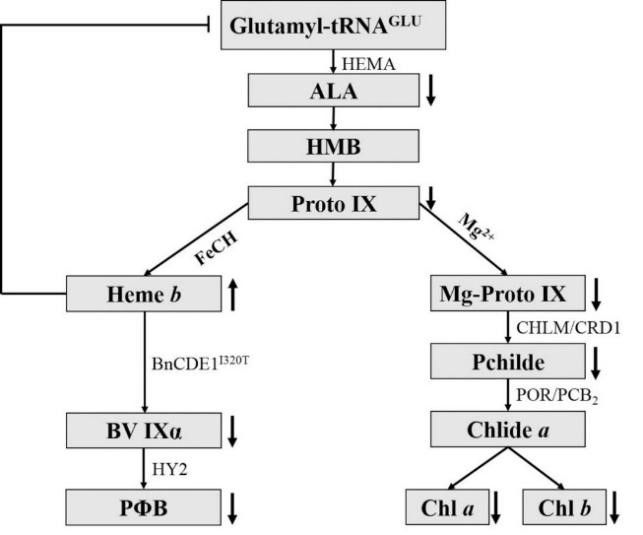搜索结果: 1-15 共查到“biosynthesis”相关记录83条 . 查询时间(0.185 秒)

南京农业大学农学院《The plant cell》发表万建民院士团队“Rice LIKE EARLY STARVATION1 cooperates with FLOURY ENDOSPERM6 to modulate starch biosynthesis and endosperm development ”(图)
万建民 酶 蛋白复合物
2024/6/11
2024年1月24日,万建民院士领衔的南京农业大学和中国农业科学院作物科学研究所的科研团队合作在国际著名期刊The plant cell在线发表了题为“Rice LIKE EARLY STARVATION1 cooperates with FLOURY ENDOSPERM6 to modulate starch biosynthesis and endosperm development ”的研究...
Brassinosteroid-Activated BRI1-EMS-SUPPRESSOR 1 Inhibits Flavonoid Biosynthesis and Coordinates Growth and UV-B Stress Responses in Plants
UV-B light BES1 brassinosteroids flavonoids
2023/12/21
Ultraviolet B (UV-B) light is a potential stress factor in plants, but how plants coordinate growth and UV-B stress responses is not well understood. Here we report that brassinosteroid (BR) signaling...

南京农业大学农学院《The Plant Journal》发表郭旺珍教授团队“Cotton GhNAC4 promotes drought tolerance by regulating secondary cell wall biosynthesis and ribosomal proteins homeostasis”(图)
郭旺珍 经济作物 发育
2024/6/11
干旱是限制植物种植分布、生长发育以及作物产量的主要非生物胁迫因素之一。棉花是重要的经济作物,新疆是中国棉花种植的主要地区,占全国棉花种植面积80%以上。干旱胁迫是影响新疆棉花生产重要的非生物胁迫因素。挖掘关键抗旱基因,揭示棉花对干旱胁迫的应答机制,培育耐逆新材料和新品种,不仅具有重要的科学研究价值,也是服务棉花可持续发展的重要保障。NAC转录因子在植物非生物胁迫信号中起着重要的转录调控作用。然而,...

南京农业大学农学院《Plant Communications》发表国家大豆改良中心盖钧镒院士和许冬清教授团队“The GmSTF1/2-GmBBX4 negative feedback loop acts downstream of blue light photoreceptors to regulate isoflavonoid biosynthesis in soybean”(图)
大豆改良 盖钧镒 许冬清 生物合成
2023/10/28
次生代谢产物异黄酮是一类主要在豆科植物中合成的多酚类物质。异黄酮不仅利于豆科植物应答生物和非生物胁迫、诱导根瘤形成等,而且对人体具有重要的保健和药用价值,比如预防和治疗癌症、心脑血管疾病和骨质疏松等。大豆是工业化生产异黄酮的重要来源,主要含有12种异黄酮物质及其衍生物。根据其化学结构的差异,可将其分为游离型苷元(aglycone)和结合型糖苷(glycoside)两大类,其中结合型糖苷占异黄酮总量...

南京农业大学农学院《The Plant Journal》发表油菜遗传育种团队“Mutation to a cytochrome P450-like gene alters the leaf color by affecting the heme and chlorophyll biosynthesis pathways in Brassica napus”(图)
油菜遗传育种 叶绿素 生物合成
2023/10/28
2023年7月28日,The Plant Journal在线发表了南京农业大学作物遗传与种质创新利用全国重点实验室油菜遗传育种团队的最新研究成果“Mutation to a cytochrome P450-like gene alters the leaf color by affecting the heme and chlorophyll biosynthesis pathways in Br...
Metabolite Profiling and Transcriptome Analysis Revealed the Conserved Transcriptional Regulation Mechanism of Caffeine Biosynthesis in Tea and Coffee Plants
茶叶中 咖啡因 NMT 生物合成
2023/4/19
Caffeine is a characteristic bioactive compound in tea and coffee plants, which is synthesized and accumulated extensively in leaves and seeds. However, little is known about the regulatory mechanism ...
Characterization of CsTSI in the Biosynthesis of Theanine in Tea Plants (Camellia sinensis)
茶氨酸 茶树 乙胺 CsTSI
2023/4/19
Theanine is a unique major amino acid in tea plants responsible for umami taste and mental health benefits of tea. However, theanine biosynthesis and physiological role in tea plants are not fully und...
CsAlaDC and CsTSI work coordinately to determine theanine biosynthesis in tea plants (Camellia sinensis L.) and confer high levels of L-theanine accumulation in a non-tea plant
茶氨酸 乙胺 谷氨酸 CsTSI Camellia sinensis L.
2023/4/19
Theanine, one of the most important components of teas, confers the umami taste and relaxation effect of tea infusion. As a non-proteinogenic amino acid, theanine solely accumulates to high levels in ...
Nitrogen-Regulated Theanine and Flavonoid Biosynthesis in Tea Plant Roots: Protein-Level Regulation Revealed by Multiomics Analyses
茶氨酸 黄酮类化合物 原花青素 茶树
2023/4/19
Theanine and flavonoids (especially proanthocyanidins) are the most important and abundant secondary metabolites synthesized in the roots of tea plants. Nitrogen promotes theanine and represses flavon...
Gibberellin biosynthesis inhibitor mepiquat chloride enhances root K+ uptake by modulating plasma membrane H+-ATPase.
MC浸种 钾离子吸收 棉花生产
2024/5/17
Shading Promoted Theanine Biosynthesis in the Roots and Allocation in the Shoots of the Tea Plant (Camellia sinensis L.) Cultivar Shuchazao
Camellia sinensis L. Shuchazao 茶氨酸
2023/4/20
Shading was thought as an effective approach to increase theanine in harvested tea shoots. Previous studies offered conflicting findings, perhaps since the integration of theanine metabolism and trans...
CsTCPs regulate shoot tip development and catechin biosynthesis in tea plant (Camellia sinensis)
Camellia sinensis CsTCP tip development catechin biosynthesis
2023/4/20
The growth of leaves and biosynthesis of characteristic secondary metabolites are critically important for tea production and quality control. However, little is known about the coordinated regulation...
OsYUC11-mediated auxin biosynthesis essential for grain filling of rice
OsYUC11 auxin grain filling rice
2023/7/20
Biosynthesis and regulation of salicylic acid and N-hydroxypipecolic acid in plant immunity
plant immunity Salicylic acid (SA) Biosynthesis
2024/2/4
Salicylic acid (SA) has long been known to be essential for basal defense and systemic acquired resistance (SAR). N-hydroxypipecolic acid (NHP), a recently discovered plant metabolite, also plays a ke...
Redundant CAMTA transcription factors negatively regulate the biosynthesis of salicylic acid and N-hydroxypipecolic acid by modulating the expression of SARD1 and CBP60g
CAMTA Salicylic acid (SA) N-hydroxypipecolic acid (NHP) SARD1 CBP60g immune signaling
2024/2/5
Two signal molecules, salicylic acid (SA) and N-hydroxypipecolic acid (NHP), play critical roles in plant immunity. The biosynthetic genes of both compounds are positively regulated by master immune-r...


